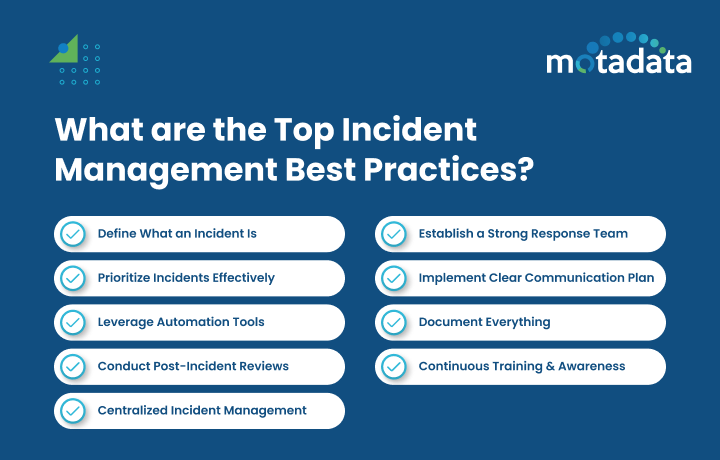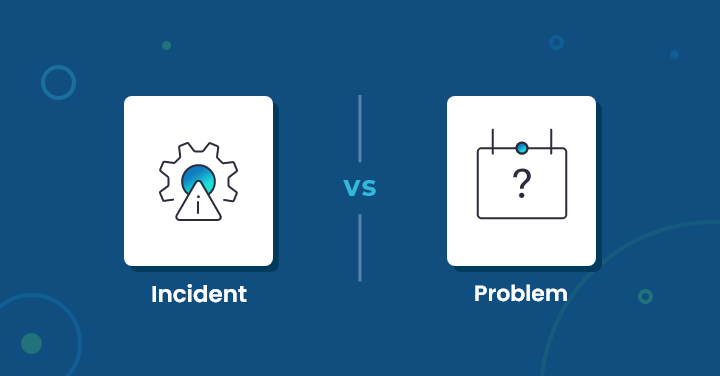The concept of ITSM has been revolutionized over time. Today, we can access all the necessary information and manage IT services anywhere.
Earlier, ITSM involved more manual processes to manage and resolve IT incidents and other issues.
But today, with the rise of technology and smartphones, people can interact with one another, resolve queries faster, and ensure smooth operations.
Incident Management is a fundamental part of ITSM and is key to maintaining regular and smooth operations with minimal downtime.
It is a crucial process that involves proper planning, assessment, and response to incidents or service interruptions in real-time.
Most IT operations and DevOps teams use this approach to address unplanned incidents.
Remember, even a minor problem can badly impact your operations and negatively impact customers.
Hence, having a strong and efficient incident management system is crucial for organizations.
With this approach, you can avoid recurring problems and respond to them in real-time.
It further ensures that you resolve and respond to issues quickly and efficiently, thus helping businesses maintain their integrity and reduce temporary downtime.
Without effective incident management best practices and systems, response delays and other challenges can occur, eventually affecting business continuity and customer satisfaction.
However, to avoid this, we have noted some robust incident management best practices that will contribute to minimal disruption and smooth operations.
Let’s discuss these best practices in detail.
What are the Top Incident Management Best Practices?
Businesses across the globe must understand the best practices of incident management in order to implement the system for their benefit.
We have listed them so that our readers can make a more informed decision.
1. Define What an Incident Is
Before diving into the best practices of incident management, let us understand what an incident is.
An incident or issue, an event that can create a big impact on your performance and operations.
Further, it can lead to unsatisfied customers and impact your goodwill.
Hence, it is crucial to categorize the problem and understand the basic criteria responsible for its occurrence.
For example, some technical incidents often occur, including application failure, system outages, and network connectivity issues.
Similarly, a few non-technical incidents like natural disasters or security breaches can disrupt your operations.
It is essential to understand the type of incident and accordingly take action. You can even categorize these incidents depending on their severity level or impact.
By defining and categorizing problems, you can ensure the use of the right resources and actions, thus minimizing the impact on business operations.
You can even provide precise guidelines on when and how problems should be reported to response teams or higher levels of management.
2. Establish a Strong Response Team
Another vital incident management best practice is establishing a strong response team.
Make sure to appoint a response team with clearly defined roles and responsibilities.
They must also have the right skills and expertise to manage different incidents.
Each team must have a representative from different departments with proper IT infrastructure and processes knowledge.
They must also be able to identify if any changes were made to the incident management workflows or processes.
Basically, if your organization has multiple products or solutions, make sure to create a team for each offering.
This will help resolve your customer queries faster, resulting in satisfied customers and quick attention to incidents.
Properly define roles and responsibilities so that there are minimal to no delays during the incident. Moreover, consider using collaboration software to ensure everyone stays aligned and responsive.
Further, conduct regular training and drills to prepare your response team for the incident management process.
A strong response team can help improve resolution time and minimize service disruptions.
3. Prioritize Incidents Effectively
You may encounter several issues and incidents daily. As a result, professionals sometimes fix minor incidents first, and the ones that could have a large impact might get missed.
This is why prioritizing your incidents is crucial.
You must understand the difference between a major incident and a high-priority incident.
If you prioritize your incidents, you can pay immediate attention to the critical events that may significantly impact your performance.
Also, categorize your incidents based on their severity level, impact, or urgency and forecast the potential effects each incident may have on the organization.
For example, a few cases can completely disrupt your service or lead to financial loss.
In such a case, you must give more priority to such incidents and address them promptly.
4. Implement a Clear Communication Plan
The organization’s lack of an organized communication might result in missing important details, needless delays, redundant work, or disinformation.
However, with a clear communication plan, you can ensure that all stakeholders are updated and notified with essential information throughout the process.
Most businesses establish communication boundaries between stakeholders and resolvers; stakeholders may want high-level information, while resolvers must be informed of every development.
So, ensure your team members use a common communication channel to address incidents, such as email or chat options.
Secondly, whenever an incident is detected, a notification is sent immediately to all IT teams, DevOps, the support team, and other members of the management, with the information outlined in bold.
Further, secure protocols must exist to prevent unauthorized users’ misuse of information or data leakage.
5. Leverage Automation Tools
Using automated tools can be easily identified as one of the most sought-after incident management best practices that can significantly benefit your business and reduce the workload on IT teams.
You can streamline all the processes by leveraging automation tools and improving your incident response time.
While automating the entire incident response process might not be possible, there are still ways that tools can help.
These include collecting data while the team handles the incident, ensuring that everyone who needs to be notified receives it, and screening the data to identify patterns.
Further, several AIOps platforms use artificial intelligence and machine learning techniques to identify anomalies and suggest resolutions.
You can use these tools to resolve incidents and prevent any negative impact on your operations.
Establish automatic incident response workflows that, depending on the features or severity of the occurrence, may initiate predetermined operations. A few examples are restarting the system or an application or receiving notice alerts.
Further, you can use these tools for automatic monitoring to enable proactive incident management with minimal manual errors.
As a result of automation, your incident management procedure will become more efficient and straightforward.
6. Document Everything
Another best incident management practice you must implement is maintaining proper records of all incidents.
With comprehensive documentation, you can capture all the details of the incident, analyze it, and devise a solution accordingly.
Further, these comprehensive documents help you explore your mistakes and learn lessons to prevent them from happening again.
You can also constantly improve your performance and ensure full-time availability with zero downtime.
You need only document everything and store it in a centralized system for quick analysis and easy access when the team is working on important issues; having a central database where all the information is gathered saves much time compared to searching various Google Docs, Notion, and other platforms for papers and checklists.
Additionally, cover all details in the documents, such as the type of problem, assessment details, actions taken for problem resolution, and more.
You can use incident templates for better consistency, knowledge base, and quick sharing.
Another important point is ensuring the documentation satisfies legal standards and is a foundation for any necessary reporting to regulatory authorities and stakeholders.
7. Conduct Post-Incident Reviews
Another key incident management best practice is using post-incident reviews (PIRs), which help professionals analyze past incidents and identify the root cause of the problem.
Analysis through this best incident management practice can help IT teams prevent such incidents from occurring again. So, run a root cause analysis and understand the underlying factors.
Further, identify the areas of improvement and check if similar incidents were responsible for the current incident.
Also, review the suggestions provided by incident management tools and documentation for reference.
Additionally, track MTTR and feedback from PIRs. By implementing these incident management best practices, you can enhance the effectiveness of the incident response.
8. Provide Continuous Training and Awareness
Your team must be capable of handling and responding to incidents effectively.
Proper training must be provided to ensure they don’t miss any facts and respond well to customers.
You can better educate team members about their roles and responsibilities by running awareness campaigns and training programs.
As a result, they will promote a vigilance culture and quickly respond to the customer’s concerns.
Further, in the provided training sessions, employees will gain a deeper knowledge of the latest tools, techniques, and best practices. Moreover, you can explore the mentorship definition and set up mentoring sessions to pair experienced employees with newer ones, fostering knowledge transfer and accelerating skill development.
Applying these practices in relevant areas can bring in great results.
To evaluate the capability of the incident response team and pinpoint areas for development, you must also occasionally execute simulated incident response drills.
These drills aid in improving incident management procedures and guaranteeing readiness.
They help pinpoint weaknesses, assess performance, and make necessary corrections, which can later help your team maintain composure under pressure and prepare for ongoing challenges.
9. Use a Centralized Incident Management System
A centralized incident management system allows IT teams to record and analyze all log files and performance metrics from a single place.
Further, it helps monitor and manage all problems or issues without any hassle as all the information is available in one place, i.e., you can detect the root cause and suggest recommendations easily.
Even all stakeholders and IT team members can communicate and collaborate much more easily with a unified platform availability that further reduces miscommunication and offers a single source of truth.
Each team member can put their viewpoints forward for discussion, and each department can participate.
This system can receive customer feedback and alerts related to incidents in one place.
This helps eliminate the high chance of miscommunication and saves time in driving process improvement.
Conclusion
An IT incident is any disruption that can interrupt your business continuity and operations.
End users can even raise issues on service quality due to the impact of an incident. Businesses invest in incident management tools to ensure smooth functioning and quick resolution.
These tools can quickly control unplanned events or interruptions to IT services and restore them within agreed SLAs.
There are several incident management tools available in the market, for example, Motadata, Jira Service Management, and more, that can respond to IT Service Management issues and disruptions much faster.
Following the best incident management practices is crucial for all businesses, regardless of size or industry.
All you need to remember are some of the incident management best practices that will ease the process and help you restore your critical business operations without impacting performance.
Build a strong response team and a clear communication plan for better management.
Further, incident prioritization and a centralized system are highly crucial. You must also document all the details related to the problem for future incident resolution.
Also, ensure that your entire response team is skilled and certified. If not, continuous training and awareness programs should be run in the first place to manage critical incidents better.
Follow the incident management best practices above to sustain service continuity and offer customer support.
Properly implementing these best practices can maintain your company’s goodwill, reduce temporary downtime, and enhance productivity.
These practices provide more visibility into issues and help IT managers spot and fix trends before the problem escalates.








